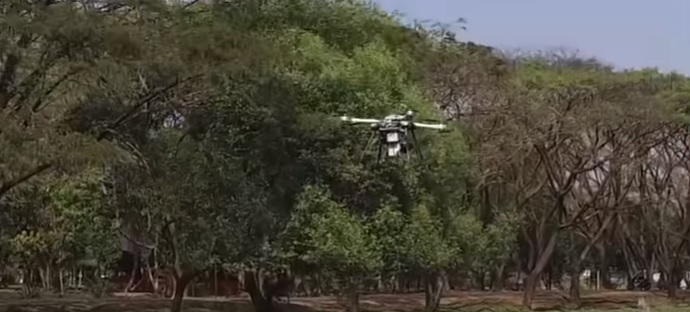Tree-Planting Drones Save The Planet With Missiles

According to the World Resources Institute, humanity has managed to destroy more than 80 percent of the Earth’s natural forests, with ongoing deforestation occurring at a rate of 20,000 hectares (about 49,421 acres) per day. This damage to our natural resources has resulted in soil erosion, the loss of forest-dwelling species, more polluted water, less clean air, and the destruction of indigenous communities that rely on the forest for their way of life.
We’ve known about this crisis for many years, with no clear policy solution in sight. Fortunately, a few smaller organizations are helping to fix the problem in their own small way. One of these organizations is BioCarbon Engineering, a technology company that was founded by and uses drones developed by ex-NASA engineer Lauren Fletcher. The company provides mapping, data analytics, and direct seeding to its customers in the forestry services.

It also plants trees with missiles.
Yes, really.
Last September, in a remote field south of Yangon, Myanmar, BioCarbon Engineering planted thousands of mangroves by firing speed missiles that move with enough force to plant themselves into the dirt. Each “missile” contains a biodegradable pod that is filled with a germinated seed and nutrients to help the tree grow. The saplings planted through this method have now risen to heights of 20 inches tall, providing BioCarbon Engineering with valuable insight into how to plant trees with drones.
“We now have a case confirmed of what species we can plant and in what conditions,” said the company’s co-founder, Irina Fedorenko. “We are now ready to scale up our planting and replicate this success.”
How much are they scaling up? Well, the organization they’re partnering with – the Worldview International Foundation, which is heavily involved in environmental and biodiversity protection in Southeast Asia – hopes to use BioCarbon’s drones to plant no fewer than 4 million trees by the end of the year. Considering it has taken Worldview over seven years to plant 6 million trees so far, this will clearly be a huge step up in production. But as crazy as it may sound, representatives of both organizations estimate that with two local workers being trained to operate a fleet of ten drones, up to 400,000 trees could be planted with seed missiles each day.
Worldview’s ultimate goal is to re-plant a billion trees in Myanmar to replace the 350,000 hectares of coastal forest destroyed by humanity. That’s an area approximately the size of Rhode Island. No wonder the nonprofit has turned to the help of technology – in the words of Worldview Impact founder and CEO Bremley Lyngdoh, “Obviously, planting a billion trees will take a long time without the help of drones.”
It should be noted, however, that drones cannot fully replace humans in the important battle for plant restoration. For one thing, some seeds don’t fit inside the pods, and we all know how hard it is to add on to the weight carried by a particular drone. For another, people living nearby need a reason to leave the trees standing. That’s why Worldview also works closely with communities in the area to help them rise from poverty (so they won’t need to cut the trees down) and teach them how to take care of the new saplings.
“The project in Myanmar is all about community development and enabling people to care for trees, providing them with jobs, and making environmental restoration in a way that it’s profitable for people,” Fedorenko told Fast Company. “The forest didn’t vanish by itself—the forest was cut down by local people.”
Sustainable, person-centric climate solutions with a drone-based technological edge – now that’s progress we at Dronethusiast can get behind!






I think these drones you developed to plants are going to be a gift for the mother earth and to the human race. It is not only Myanmar,but every country on earth should adopt a policy, to use these drones to plant back all the trees we cut down so far, and bring back all those forests we lost. God bless you all.